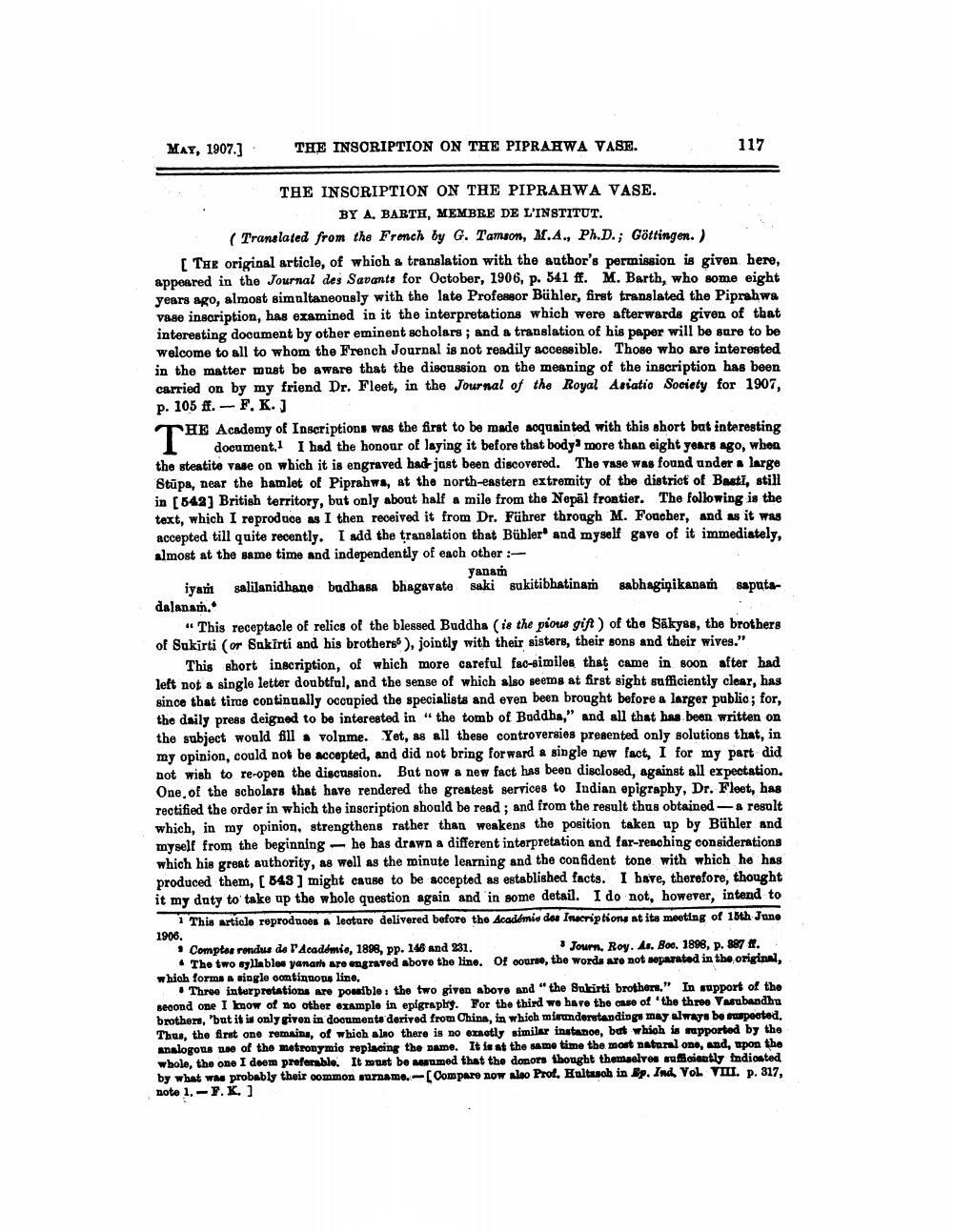________________
MAY, 1907.)
THE INSCRIPTION ON THE PIPRAHWA VASE.
117
THE INSCRIPTION ON THE PIPRAHWA VASE.
BY A. BARTH, MEMBRE DE L'INSTITUT. ( Translated from the French by G. Tamson, M.A., Ph.D.; Göttingen. ) [The original article, of which a translation with the author's permission is given here, appeared in the Journal des Savants for October, 1906, p. 541 ff. M. Barth, who some eight years ago, almost simultaneously with the late Professor Bühler, first translated the Piprahwa Vase inscription, has examined in it the interpretations which were afterwards given of that interesting document by other eminent scholars; and a translation of his paper will be sure to be welcome to all to whom the French Journal is not readily accessible. Those who are interested in the matter must be aware that the discussion on the meaning of the inscription has been carried on by my friend Dr. Fleet, in the Journal of the Royal Asiatic Society for 1907, p. 105 ff. - F. K.) THE Academy of Inscriptions was the first to be made aoquainted with this short but interesting
1 document. I had the honour of laying it before that body more than eight years ago, when the steatite vase on which it is engraved had jast been discovered. The vase was found under a large Stūpa, near the hamlet of Piprahwa, at the north-eastern extremity of the district of Basti, still in (542) British territory, but only about half a mile from the Nepal frontier. The following is the text, which I reproduce as I then received it from Dr. Führer through M. Foucher, and as it was accepted till quite recently. I add the translation that Bühler and myself gave of it immediately, almost at the same time and independently of each other :
yanam iyar salilanidhane badhasa bhagavate saki sukitibhatinam sabhaginikanan saputer dalanan..
"This receptacle of relics of the blessed Buddha (is the pious gift) of the Sakyas, the brothers of Sukirti (or Sukirti and his brothers , jointly with their sisters, their sons and their wives."
This short inscription, of which more careful fac-similes that came in soon after had left not a single letter doubtful, and the sense of which also seems at first sight sufficiently clear, has since that time continually occupied the specialists and even been brought before a larger public; for, the daily press deigned to be interested in the tomb of Buddha," and all that has been written on the subject would fill volume. Yet, as all these controversies presented only solutions that, in my opinion, could not be accepted, and did not bring forward & single new fact, I for my part did not wish to re-open the discussion. But now a new fact has been disclosed, against all expectation. One of the scholars that have rendered the greatest services to Indian epigraphy, Dr. Fleet, has rectified the order in which the inscription should be read; and from the result thus obtained -& result which, in my opinion, strengthens rather than weakens the position taken up by Bühler and myself from the beginning - he has drawn a different interpretation and far-reaching considerations which his great authority, as well as the minute learning and the confident tone with which he has produced them, ( 348 ) might cause to be accepted as established facts. I have, therefore, thought it my duty to take up the whole question again and in some detail. I do not, however, intend to
1 This article reproduces a leoture delivered before the Académie des Inscriptions at its meeting of 18th June 1906. • Comptes rendus de l'Académie, 1898, pp. 146 and 231.
Journ. Roy. At. 8oo. 1898, p. 887 #.. • The two syllable yanamh are engraved above the line. Of course, the words are not separated in the original, which forms a single continuous line.
• Three interpretations are posible: the two given above and "the Sukirti brothers." In support of the second one I bow of no other example in epigraphy. For the third we have the case of 'the three Vasubandhu brothers, but it is only given in doouments derived from China, in which misunderstandings may always be rupeeted. Thus, the first one remains, of which alo there is no exactly similar inatanoe, but whioh is rapported by the analogous use of the matronymio replacing the name. It is at the same time the most natural one, and, upon the whole, the one I deem preferable. It must be mumed that the donors thought themselves wufciently indicated by what was probably their common murnamo.-[Compare now aloo Prot. Haltasch in Wp. Ind. VoL VILL. P. 317, note 1.-9. K.)




